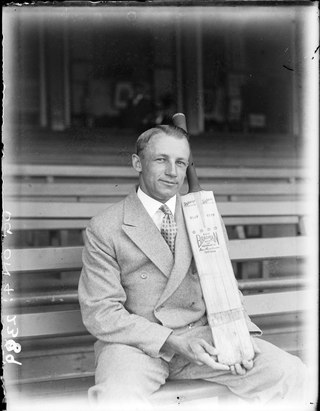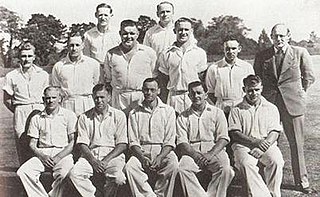Related Research Articles

Sir Leonard Hutton was an English cricketer. He played as an opening batsman for Yorkshire County Cricket Club from 1934 to 1955 and for England in 79 Test matches between 1937 and 1955. Wisden Cricketers' Almanack described him as "one of the greatest batsmen in the history of cricket". He set a record in 1938 for the highest individual innings in a Test match in only his sixth Test appearance,scoring 364 runs against Australia,a milestone that stood for nearly 20 years. Following the Second World War,he was the mainstay of England's batting. In 1952,he became the first professional cricketer of the 20th century to captain England in Tests;under his captaincy England won the Ashes the following year for the first time in 19 years.

Walter Reginald Hammond was an English first-class cricketer who played for Gloucestershire in a career that lasted from 1920 to 1951. Beginning as a professional,he later became an amateur and was appointed captain of England. Primarily a middle-order batsman,Wisden Cricketers' Almanack described him in his obituary as one of the four best batsmen in the history of cricket. He was considered to be the best English batsman of the 1930s by commentators and those with whom he played;they also said that he was one of the best slip fielders ever. Hammond was an effective fast-medium pace bowler and contemporaries believed that if he had been less reluctant to bowl,he could have achieved even more with the ball than he did.

Norman Walter Dransfield Yardley was an English cricketer who played for Cambridge University,Yorkshire County Cricket Club and England,as a right-handed batsman and occasional bowler. An amateur,he captained Yorkshire from 1948 to 1955 and England on fourteen occasions between 1947 and 1950,winning four Tests,losing seven and drawing three. Yardley was named Wisden Cricketer of the Year in 1948 and in his obituary in Wisden Cricketers' Almanack,he was described as Yorkshire's finest amateur since Stanley Jackson.

The Australian cricket team in England in 1948 is famous for being the only Test match side to play an entire tour of England without losing a match. This feat earned them the nickname of "The Invincibles",and they are regarded as one of the greatest cricket teams of all time. According to the Australian federal government,the team "is one of Australia's most cherished sporting legends". The team was captained by Don Bradman,who was making his fourth and final tour of England.

Walter Arnold Hadlee was a New Zealand cricketer and Test match captain. He played domestic first-class cricket for Canterbury and Otago. Three of his five sons,Sir Richard,Dayle and Barry played cricket for New Zealand. The Chappell–Hadlee Trophy,which is competed for by ODI teams from New Zealand and Australia is named in honour of the Hadlee family and the Australian Chappell family.

Douglas Thomas Ring was an Australian cricketer who played for Victoria and for Australia in 13 Test matches between 1948 and 1953. In 129 first-class cricket matches,he took 426 wickets bowling leg spin,and he had a top score of 145 runs,which was the only century of his career.

Bruce Hamilton Pairaudeau was a West Indian cricketer who played in 13 Test matches between 1953 and 1957. Born in British Guiana,he moved to New Zealand in the late 1950s.

John Cowie was a New Zealand cricketer who played in nine Tests from 1937 to 1949. His Test opportunities were restricted by New Zealand's limited programme,and his cricket career was interrupted by World War II from 1939 to 1945. Following the 1937 tour of England,Wisden commented:"Had he been an Australian,he might have been termed a wonder of the age."

Frank Brunton Smith was a New Zealand cricketer who played in four Tests between 1947 and 1952. He played first-class cricket for Canterbury from 1946 to 1953. His father Frank played for Canterbury in the 1920s;Brun's son Geoff played for Canterbury in the 1970s.
Bruce Alfred Bolton is a former New Zealand cricketer who played in two Tests in 1958–59.
Brian Frederick Hastings is a former New Zealand cricketer. A middle-order batsman,he played 31 Test matches between 1969 and 1976,scoring four centuries. He played first-class cricket for Wellington,Central Districts and Canterbury between 1958 and 1977.
1947 was the 48th season of County Championship cricket in England. It is chiefly remembered for the batting performances of Denis Compton and Bill Edrich who established seasonal records that,with the subsequent reduction in the number of first-class matches,will probably never be broken. Their form was key to their team Middlesex winning the County Championship for the first time since 1921,although they were involved in a tight contest for the title with the eventual runners-up Gloucestershire,for whom Tom Goddard was the most outstanding bowler of the season. Compton and Edrich were assisted by the fact that it was the driest and sunniest English summer for a generation,ensuring plenty of good batting wickets.
The New Zealand cricket team toured England in the 1949 season. The team was the fourth official touring side from New Zealand,following those in 1927,1931 and 1937,and was by some distance the most successful to this date. The four-match Test series with England was shared,every game ending as a draw,and of 35 first-class fixtures,14 were won,20 drawn and only one lost.
The New Zealand cricket team toured England in the 1958 season. In a notably wet summer when the touring side lost the equivalent of 29 full days of cricket,the side lost four of the five Test matches. In first-class matches,they won six of their first nine games,but then won only one more all season,although they only lost two matches outside the Tests,both of them to Surrey.
The New Zealand cricket team toured England in the 1965 season,playing three Test matches in the first half of a damp summer. England later hosted a second three-match series against South Africa,the first time two Test series were played in a single English cricket season since the 1912 Triangular Tournament.
The New Zealand national cricket team toured South Africa from October 1953 to February 1954 and played a five match Test series against the South Africa national cricket team. South Africa won the Test series 4–0. The tour was the first by a representative New Zealand side to South Africa and the tourists embarked on their visit without having won a Test match since they had been granted full member status of the Imperial Cricket Conference in 1930.
The New Zealand national cricket team toured South Africa from October 1961 to February 1962 and played a five-match Test series against the South Africa national cricket team. The series was drawn 2–2,with New Zealand's victory in the third Test the team's first Test match win outside their home country. New Zealand captain John Reid scored a total of 1,915 runs during the tour,setting a record for the most runs scored in South Africa by a touring batsman. The tour was the second to South Africa by a team from New Zealand,the previous tour having taken place in 1953–54.
The South Africa national cricket team toured Australia in the 1952–53 season and played five Test matches against Australia. The series was drawn 2–2,the first time a rubber between the two sides had not been won by Australia.

Ernie Toshack was a member of Donald Bradman's famous Australian cricket team,which toured England in 1948 and was undefeated in their 34 matches. This unprecedented feat by a Test side touring England earned Bradman's men the sobriquet The Invincibles.
Lindsay Hassett was the vice-captain and one of three on-tour selectors for Don Bradman's famous Australian cricket team,which toured England in 1948. The Australians went undefeated in their 34 matches;this unprecedented feat by a Test side touring England earned them the sobriquet The Invincibles,and resulted in them being regarded as one of the greatest teams of all time. A right-handed batsman,Hassett played in all five Tests;he was a middle-order batsman in all but the Fourth Test,when he stood in as an opener due to an injury to Sid Barnes.
References
- ↑ "Jack D'Arcy". CricketArchive. Retrieved 23 May 2022.
- ↑ "Cricket: High School Well Placed". Press: 8. 20 March 1952.
- ↑ Wisden 1959, p. 239.
- ↑ "First-Class Batting and Fielding in Each Season by Jack D'Arcy". CricketArchive. Retrieved 2 April 2023.
- ↑ Wisden 1959, p. 243-53.
- ↑ "Yardley Assesses N.Z. Cricket Team". Press: 13. 4 September 1958.
- ↑ Christopher Martin-Jenkins, The Complete Who's Who of Test Cricketers, Rigby, Adelaide, 1983, p. 384.
- ↑ John Reid, Sword of Willow, A.H. & A.W. Reed, Wellington, 1962, p. 133.
- ↑ "The Computer Age Has Arrived". Press: 19. 8 July 1965.
- ↑ Ghosh, Mayukh. "Jack D'Arcy: Heartthrob with a short career". CricMash. Retrieved 27 January 2021.